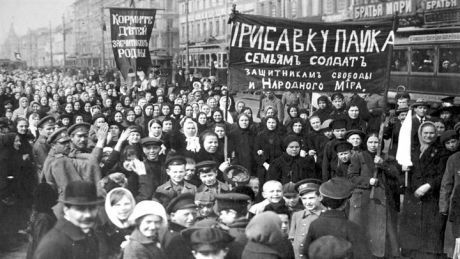Features
You are here
1917: how the revolution was won

October 18, 2017
The overthrow of the Russian Tsar in February 1917 was the spontaneous result of the anger of the Russian masses erupting in mass demonstrations that paralyzed Petrograd and numerous other Russian cities. Within days, the once all-powerful Tsar was isolated and he was forced to abdicate.
In 1917 Russian society was devastated by poverty and the violence of the First World War. That February, women workers at factories in Petrograd organized strikes and demonstrations to mark International Women's Day, and to demand an end to food shortages. The demonstrations spread quickly, and even the Bolsheviks were taken by surprise. With the Tsar unable to count on the usual support of the Imperial Army, his regime crumbled, and in less than a week he was gone, replaced by a Provisional Government.
Within days of the International Women's Day demonstrations, workers in several cities took the example of Russia's upheaval of 1905 and formed workers' councils (советы, or "soviets" in Russian). Factory worker formed committees, sending representatives to larger councils from different districts of cities and city-wide soviets. Other social groups, including soldiers and sailors, formed similar councils, and sent representatives to the councils.
The new Provisional Government was made up of parties nominally opposed to the Tsar, but in reality representing Russia's capitalists. The Bolsheviks and other radical parties were excluded. This government was committed to continuing the war effort. The resulting situation of "dual power" was inherently unstable.
Initially, however, the workers' councils lacked the confidence to assert their authority against the Provisional Government. When the first national congress of soviets was convened, the Bolsheviks represented a minority of delegates; the soviets' leadership came from moderate left parties like the Mensheviks and Socialist Revolutionaries (SR). When Lenin returned to Russia from exile in Switzerland he shocked his comrades by demanding that they reject cooperation with the Provisional Government and commit themselves to a new revolution that would transfer power to the soviets. Lenin recognized that the masses of workers, while they might not have the confidence to assert their power immediately, had shown by their actions that they wouldn't tolerate a government that continued policies of war and exploitation.
After temporary gains during the July days and the arrest or temporary exile of several Bolshevik leaders, things started to go poorly for the Provisional Government, and the Bolsheviks continued to gain strength in the soviets--including organizing workers to stop a military coup. When the Bolsheviks finally seized power in October, after democratically winning a majority in the soviets, they took immediate action. The new workers' state ended Russia's participation in the First World War; the long-oppressed peoples of the Russian Empire (“the prison house of nations”) were given self-determination; in a country notorious for anti-Semitic pogroms, Jews led the workers' councils of Russia's two largest cities; laws outlawing homosexuality were repealed; abortion was legalized and made available on demand. These measures only scratch the surface of the experiments of the Russian Revolution, from workers' control over their workplaces to efforts to make women truly equal in society, to a new flowering of art and culture.
This is the first in a four part series of articles commemorating the 100th anniversary of the Russian Revolution. The next articles will look at the gains of the revolution, how the revolution was lost, and lessons for socialists today.
Join the events “Ten Days That Shook the World”, next Wednesday October 25 in Vancouver, Toronto or Ottawa
Section:
Topics:










